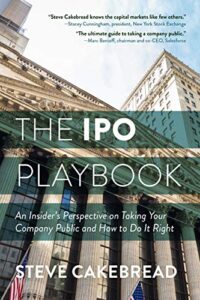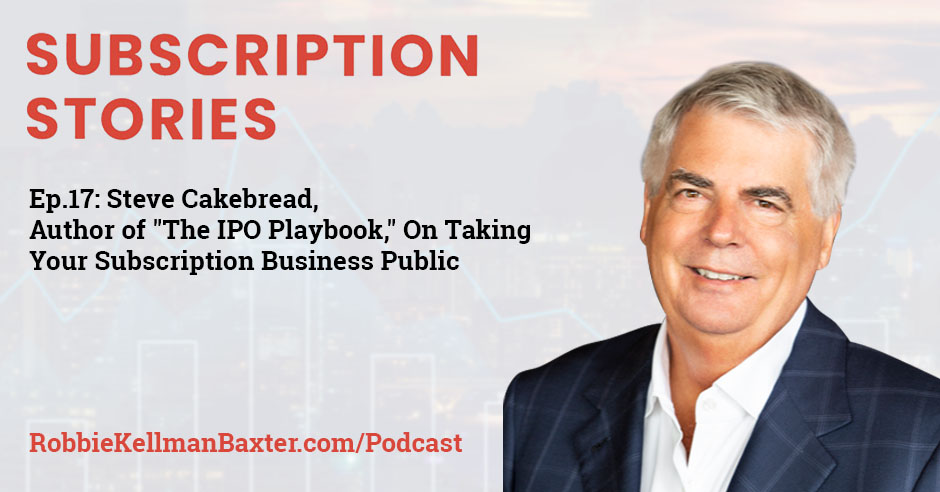
Today’s guest, Steve Cakebread, knows a great deal about subscription pricing models and IPOs. Steve has brought three notable subscription-based companies—Salesforce, Pandora, and Yext—to successful initial public offerings, or IPOs, and served on the board of three other subscription-based companies – eHealth, SolarWinds, and Bill.com – as those companies went public. Steve is frequently sought-out for his advice on IPOs, often fielding three or more requests in a single week. He decided to put his advice on the subject into a new book, The IPO Playbook: An Insider’s Perspective on Taking Your Company Public and How to Do It Right. On today’s show, Steve sits down with Robbie Kellman Baxter for a discussion on why investors love subscriptions, how to take your subscription business public, what it takes to build a solid foundation, and how to tell your subscription story in a way that investors will understand.
—
Listen to the podcast here:
Steve Cakebread, Author Of “The IPO Playbook,” On Taking Your Subscription Business Public
Our guest, Steve Cakebread knows a great deal about subscription pricing models and IPOs. Steve has brought three notable subscription-based companies, Salesforce, Pandora, and Yext to successful initial public offerings or IPOs and served on the board of many other subscription-based companies including eHealth, SolarWinds, and Bill.com. Steve is frequently sought out for his advice on IPOs, often fielding three or more requests in a single week. He decided to put his advice on the subject into a book, The IPO Playbook: An Insider’s Perspective on Taking Your Company Public and How to Do It Right. We’re going to be talking about why investors love subscriptions, what it takes to build a solid foundation, and how to tell your subscription story in a way investors will understand.
—
Steve, welcome to the show.
Robbie, thank you very much. It’s great to be here.
Let’s start with some definitions. Can you define what an IPO is and why it’s important?

“An IPO is a powerful and meaningful step in the business, but it’s also one that you should enjoy and take advantage of.” – Steve Cakebread
An IPO is an Initial Public Offering where you take your company stock and for the first time, trade it publicly on an exchange. It gives you access to capital markets. It gives you awareness of your business and it provides liquidity for your employees, as well as gaining access to other investors that might help you run your business. That’s a powerful and meaningful step in the business, but it’s also one that you should enjoy and take advantage of. Usually, entrepreneurs can go through the IPO route and get their companies listed publicly because it gives liquidity to their employees or you can keep your business and keep running it.
That’s what my family has done at the winery. We have a successful business and we keep running it as if it’s a real business. We have a board of directors, outside advisors, auditors, and everything you would do if you’re a public, but we run it as a private business. We’ve chosen not to sell it to anybody else because we enjoy the business that we’re in. We’ve chosen not to go public because the business runs quite well as a private company and doesn’t need additional capital that you might get from the public market.
It’s an interesting point. Number one, an IPO is a way of selling part of your business. You may or may not want to sell part of your business. There are all kinds of good reasons to do it and not to do it. The second point that you bring up that’s important is that even if you choose not to sell part of your business through a public offering or making it available to the public, it may still make sense to apply the same level of rigor in running your business as a private entity, as you would be forced to do if you wanted to take the business public.
I fundamentally feel and we’ve seen it at our own family business. You want to operate it as a real business and real businesses need financial systems. They need business metrics and marketing. They need outside advisors to make sure that you’re meeting all the standards that you need. You also need access to capital. Private companies generally reinvest their capital, so they don’t have to go outside, but if you’re a rapidly growing business, additional capital always helps you grow faster and go farther with it. That’s why most of the companies that look to IPO are rapidly growing businesses that want access to additional capital.
It’s not just selling shares. Once you get listed on the New York Stock Exchange, and on my book I talk about this a bit in terms of you can do debt offerings and convertible debt offerings. There are a myriad of ways that you can get access to a more efficient capital market when you’re public than if you’re private where you have to go either work with a single bank to borrow money or reinvest as we do at the winery and our own business. It depends on what your longer-term goal is and the rate of growth of your company because fast-growing companies do consume capital in the early days typically. Particularly subscription models, as you try and build out your sales organization, it consumes capital.
People reading Subscription Stories are for the most part entrepreneurs and executives that are building subscription businesses. Many of whom are doing it because they know that subscription-based businesses are deemed more valuable by investors, whatever investors means to them. Having an understanding of why you might want to have an IPO, why you might want to bring strangers to your table effectively is important to consider before you take anyone’s money. If you’re growing fast and you need more to fuel your growth, an IPO can be a way to give you not just that first infusion of capital but lots of additional possibilities and options to have at your disposal, but it comes at a price and you need to understand that as well.
Subscription Stories Podcast episode with @SMCakebread discussing why investors love subscriptions, what it takes to build a solid foundation for market value creation, & how to tell your subscription story in a way that investors… Share on XYou’ll find that in the investors that I’ve worked with for Salesforce and Pandora. They are fairly sophisticated, and they’ll give you ideas on how to improve the value of the company. Remember, it’s all about increasing the value of the company itself. The public markets probably give you the best look at the valuation of your company. Subscription businesses have traditionally been valued highly because of the predictability of the revenue streams and the cashflow. Those investors that you bring in a public offering are also people that can help you move your thought process along. Having numerous calls with some of our biggest investors at Yext, to get their inputs, as well as tell them what we’re doing.
There are regulations about what we can say but there is a two-way dialogue. A lot of investors these days are fairly sophisticated in maximizing or helping you think about ideas to maximize the value of your company going forward. That’s been beneficial. You tend to have fewer people involved, if it’s in the private markets or if you’re borrowing money from your favorite loan officer at the neighborhood bank. You have to look at how many people you want to be involved in it, but sometimes the breadth of those investors adds a lot of value to your business as well.
I like how you framed that if you’re building a business, on one end of the spectrum, you can borrow from your friends, neighbors and your local bank. At the other end of the spectrum, you can work with the public markets to bring in a lot of different kinds of possibilities and experts, which can be empowering and give you greater flexibility as you grow and expand your business footprint. You were part of Salesforce. How soon did you know that subscription pricing was going to be a core part of the story? What was the impact of subscriptions on the journey to the public offering?
It’s the history that Marc Benioff and I share together. I was the second CFO at Salesforce. The first management team was more traditional and they kept billing customers at the end of the month for what they use. It’s a usage billing model, which we see all the time. The thing was that wasn’t working because you’re subsidizing all your customers’ cash. They may not pay on net 30, they may pay 45 or 60 days.
Meaning that I provide you with the service for the month and you don’t pay me until the end of the month instead of the beginning of the month or maybe even a month later or two months later.
I joined Salesforce with Marc with the intention of changing the business model to bill on arrears to a subscription model. Marc and I got together and we talked about the subscription model. When I joined, we joined with the full intent of putting the subscription business model into Salesforce. Within about six months, we had that model fully implemented. His choice was to change a subscription model or go raise more money because his company was growing, but billing in arrears doesn’t generate cash to hire more salespeople or engineers to grow the business. We went through that transition about six months and it was purpose-built for our subscription model going forward. We changed our cashflow because now you have customers paying you in advance for the service. In fact, the biggest change was to go from monthly billing in advance to annual.
We went through another six months of transition telling our customers, “We love you, but it’s appropriate that you sign a one-year subscription with us and you pay us in advance.” That changed the cashflow dynamics of the company to positive instead of breakeven to negative. That’s a huge change in the business model. It was a different thinking about how that business model was. We were forced to either go do another financing round, which neither one of us wanted to do or change the business model. From there on, we never looked back. It was the best thing that we’ve ever done for the company. It changed how software was sold over time.
It was quite revolutionary. The two things that you did well, one of them is to make sure that people were paying at the beginning of the month instead of at the end of the month or even 30, 45 or 60 days after the end of the month. The other thing that you did was you moved from monthly payments to annual payments. Even many years later, it’s still a question on the minds of many subscription business leaders, “Do I move to annual or do I stick with monthly?” It sounds like for Salesforce, that was another key element of your transformation.
You can manage that transformation slowly. You can go from monthly to quarterly, quarterly to semi-annual to annual. Particularly as you get customers that are with you understand the value of your subscription and the services you provide, and then it becomes easier to have the conversation about paying the upfront annually. New customers, we started that way, “This is how you get business from us. This is what you need to do. Pay us upfront and you get a year’s worth of service. At the end of the year, you don’t like it, or you don’t need it, or you want to grow, you can do that.” There are techniques and ways to get from where you’re at to where you want to be. It’s managing your existing customer-base and changing that, to new customers start out with you and your new business model. That works out fine as well.
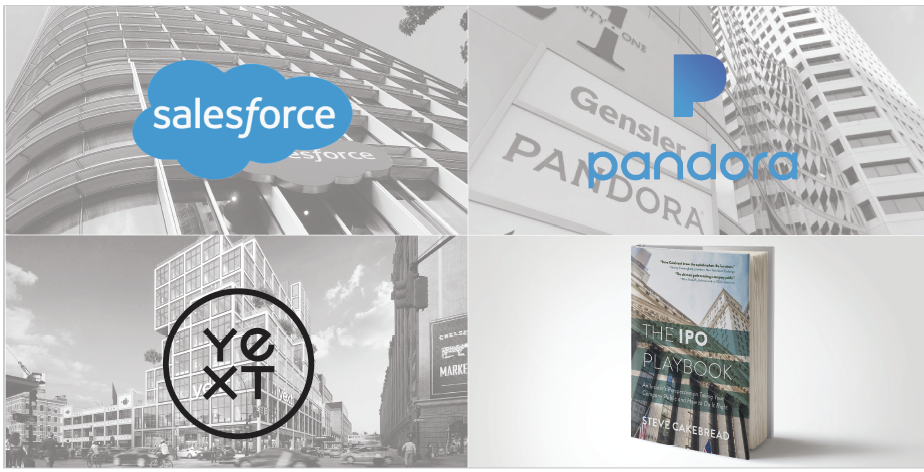
You bring up a couple of important points. One of them is that anytime you change a business model, it can be hard to bring along your longtime customers because the change makes them reconsider the purchase like, “Wait, why are you changing it? Do I still want this? Does this still make sense? Let me recalculate.” That’s one big challenge. The other thing is the fear that if I let them go month to month, there’s less of a hurdle for them to get over. A big part of subscriptions is it’s easy to join and sign up. It’s a lot easier than buying software outright. The other side of it is if I require them to commit to a year upfront, that’s a much bigger number. You have to have confidence that people who are serious are going to sign up for the year and take that risk with you, and that you’re not going to lose too many possibly great customers by requiring them to clear that hurdle from the beginning.
We went through that drama and trauma because there were 90 days where we were marketing to our install base saying we’re going to be changing these business models. We needed them committed to us as well because the downside of monthly is you can leave at the end of the month. You need that install base there because it costs you more to get a new customer than keep a customer. You want that customer committed to you, but if you’re treating your customer properly, they’re going to be with you. They’ll make those transitions. We made all kinds of exceptions but within about three years, everybody was up to speed on an annual billing cycle. It minimized their administrative work because imagine you have to sit down and write us a check every month. It starts to make it so much easier once you get to less frequent billing. They knew they had the service for the year. They didn’t have to remind themselves every month to renew. There are pros and cons, but the long-term benefit to a business in terms of increasing its value and retaining these customers for the long-term is clearly worth it over monthly billing.
There are a bunch of important ideas there. One of them is that having that hurdle can often help you distinguish between customers who are serious and who understand your value, and those that might not or are not committed, which is good for both sides. Once you ease into the relationship and you say, “This is how I’m going to do business going forward,” says that customer. It’s much easier for them to stay with you. I work with a lot of different kinds of subscription businesses as I know you do. The biggest churn almost always happens in the early periods. Once that customer decides, “This is how I’m going to get business done. This is how I’m going to solve my problem.” In most cases, they want to set it and forget it. They want to pay, not think about it, and have it work. They also need to be able to trust you as an organization that you’re going to continue improving that offering to better and better solve the problem that you set out to solve in the first place. That investment in innovation that you talked about.
We talk about it in my book. As you grow your business, you’re always adding value to the customer. In fact, that price you might pay at the beginning of the year, hopefully there are more features and values that the customer recognizes. You’re adding value to them over time and their price doesn’t reflect the incremental value-add.
A question I get all the time is what percentage of revenue should you spend on innovation? Within that innovation or new features, how much of that should be on acquisition features or headline features, “New and improved. Now offering,” versus engagement and retention features? The ones that you can’t market to new prospects because they don’t understand or value it, but that are important to keep your current subscribers happy and deepen those relationships. Do you have benchmarks or thoughts on that?
Typically, subscription businesses do have a good relationship with our customer. At Autodesk, as we were transitioning to subscription, we wanted to make sure that 25% of all the new features we put in were customer requested and customer expected because it does keep them happy and it solves problems for them that they recognize. You have to bring out new features as well. At Salesforce, we’ve got to a point where we were adding big new features every month. We cut back to four times a year because nobody could absorb so much of that feature set. You have to have a balance. Yext is the same thing. We could be adding big new features every month, but we’ve cut back to three times a year, but we always do have additional enhancements during the quarter or things that aren’t working. You owe your customer to fix those right away. We do that as well.
That’s 25% on customer improvements for the existing subscribers. That means 75% are headline features that a salesperson can talk about with a new prospect as that might attract somebody different or increase the likelihood of closing that deal. Is that fair?
That 75% is adding more value to your existing customers as well. Hopefully, it’s grand new features that they never would’ve got access to. It helps both parties dramatically.
One of the challenges, when I’ve worked with organizations that are moving from purchase transactions to subscriptions, is they’re all primed for new and improved kinds of features, new release. They don’t invest a lot in those cleanup features or even in features that are optimized around expanding the relationship or deepening the relationship, or making it easier for them to bring in their colleagues, which leads to the health of that all-important churn number.
We did take Autodesk from a purchase model to a subscription model. It took us about three years, and we were cognizant of the problem you described, how do you keep adding value to your existing customers while at the same time bringing out new features? We rolled that into our services and support business so that over time, over that three-year period, although the business didn’t grow because you were shifting to a subscription where your straight lining or amortizing your revenue, we did keep the customer-base fairly well in line.
I’m most proud of the fact that most of the people that joined me before we went public at @salesforce in leadership roles are still at Salesforce, $100 million business to $20 billion business. - @smcakebread Share on XIt was this attention to making sure every month there were releases that help the existing customers keep the software they had and they didn’t want to leave. The transition from a purchase model to subscription, you need to be thoughtful. It took us eighteen months to figure out what the right approach was going to be and how we didn’t economically damage the company and its valuation from purchase to subscription. Once we’ve done that, Autodesk has been wildly successful in internet subscription model these days. It was all because we took that 3 to 4-year period and made that transition that’s made Autodesk what it is now in terms of business model.
Three to four years, even 5 or 6 years to get from a transactional business model, especially for a large traditional company, that’s to be expected and understanding that it is a journey to get there. We’ve been talking about B2B and Software as a Service business for the most part. I want to change things around a bit and talk about Pandora. You took Pandora public. I featured Pandora in my first book as an example of an organization with a clear promise to listeners.
A lot of the processes are similar. You need good governance and good reporting tools. You need to be compliant with a number of different governmental agencies. You need a good board of directors. In our case with Pandora, we had a whole lot of obligations to report to the recording industry in terms of plays, how many and where the artists and the songwriters. There was a whole lot of external reporting that we had to do to third-party agencies because they were getting paid based on those places. The process of going public was not that different. You get to your team and the management team in place. They understand how to run a business because at the end of the day, it’s about how you run that business. They need to have an understanding of the value-add.
Pandora’s value-add, I still use it for discovering music because the algorithms that Tim Westergren put in were wonderful. It’s the most innovative in the industry and still are now. The process of going public of getting ready, doing the things right that you had to do, and then outreaching as you went public, part of going public and I talk about this in my book is raising the visibility of your company and the credibility of your company. A lot of people have to participate with you in whatever business. If you’re listed on the New York Stock Exchange, there’s a line that has guaranteed credibility of your business. Pandora, in a lot of ways, was not unlike taking Salesforce public or Yext. We did spend a lot of time thinking about the consumer and the listener, and making sure that they had access to potentially buying the company or investing in the company.
That’s why you saw us go out when we did it. One of my theses is you want to take your company public at a range where other individuals like myself, yourself and others can invest in it. That range to me is somewhere between $10 and $20 a share. You want more people invested in your company. You want a lot of individual investors invested in your company, particularly at Pandora because the individuals were listeners and a grander audience as well. The process was similar to Yext and Salesforce to a large degree.
Having customers as investors is important to you.
It keeps you connected. Having that emotional attachment from a listener to the company was a good thing. It kept us as managers and executives connected with the listener because we would do a lot of listener events, bringing in bands and showcasing them along with the listeners. A lot of listeners that come said, “I want 3 or 5 shares of your stock. I believe in you.” That if nothing else, when you’re running a business is always nice to hear.
Especially in a membership-based business that’s operating as a subscription, it’s important that your members, your subscribers, your listeners feel a connection to the organization. Owning a piece of the business is a powerful way to feel like you belong. Some people say that IPOs are outdated and too much work. The company is separated from the markets by a bunch of investment professionals, but I know you believe in the process. You say in the opening of your book, “I’m going to make the argument that an IPO is the best long-term strategy for most companies.” Beyond the funds raised, what do you think is the value of the IPO process for a subscription business?
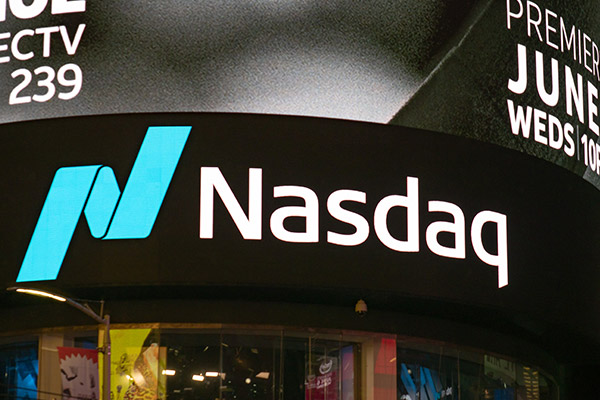
“The subscription business, regardless of IPO or not, is all about a disciplined go-to market approach.” – Steve Cakebread
One, it brings discipline. The subscription business, regardless of IPO or not, is all about a disciplined go to market approach. Going public creates that governance and process discipline within your company that is necessary to run a basic business. I view that as a push. If you’re going to run a great subscription business, it probably means you have great governance, you have the metrics and data to understand what your customers are doing, and how they’re reacting to your product. That’s no different than being public. The public side of it as I describe in the book gives those people that committed you to get the business to where it’s at liquidity on their investments. It gives you other investors. Sometimes, getting more people in to help you understand what’s successful and buy your product is good.
The days we went public for all three companies, I was the number one marketeer in the company. I generated more leads throughout the world for all three of those businesses than marketing ever did up to that period of time. Awareness-raising is never a bad thing for a company and IPO has helped that out. You get access to all the other people and the liquidity effect. The awareness effect is all huge, particularly if you’re going to take your company outside the US. That’s another way to get awareness built-in international markets that you typically wouldn’t think of if you were just in the US.
It’s as much about credibility building and brand building as it is about the funds themselves it seems. You talked about how you came into Salesforce to help rethink the business model, and then you took them public with Marc Benioff. How do you find a CFO who gets subscriptions? If you’re looking to bring in a CFO or somebody to take you public, what should you be looking for in that financial person who’s going to be at the table both for scaling the business, running the business, and readying it for the IPO?
If you're treating your customer properly, they're going to be with you and make transitions along with you. - @smcakebread Share on XIt’s not necessarily my vision. I love Marc Benioff when his interviews go like, “I have a vision. I’m hiring you to help make that happen.” As you get into it, I’m not there to change his vision. What I am there to do as a CFO is to help improve that vision, make it more effective and efficient. Number one, make sure you can have a good dialogue with your CFO. Number two, they need to have an operating background, not just the financial numbers background, because it is about the operations. This is all about running a business at the end of the day. Number three, an ability to recruit great talent. None of us know everything. A rapidly growing business needs more people, not less people. One of the strengths that I always brought to my businesses was the ability to hire great talent to help that company scale over time.
I’m most proud of the fact that most of the people that joined me before we went public at Salesforce in leadership roles are still at Salesforce, $100 million business to $20 billion business. They’re senior leaders there. That’s great hiring at the beginning. The same thing with Pandora, I brought in a team that was still there until they got acquired at Sirius. At Yext, I hope that will be the same thing. You can see the people growing into these roles and gaining the experience. That ability for a senior executive to recruit is critical as well.
We’re talking in the midst of a second spike in COVID cases here in the United States. How has the global pandemic affected the public markets? What do you hear from your friends at the stock exchanges and from investors, especially the private equity firms?
There are a couple of things here. One is particularly in the arenas that I’ve been in, in technology and consumer. This isn’t going to last forever. We will get through this to some other form of normal or new normal. One of them is to take your business and get it ready to grow when things turn around. Both at the winery and at the businesses I’ve been in, we’ve been focused on keeping our workforce because when things do get better, that workforce is going to be more tenured, more skilled, and more productive. They see a sense of loyalty to you as an employer, which is critical. On the investor side, there isn’t anybody that will dispute the fact that the stock markets are disassociated with reality in the commercial market. They’re looking more forward. They’re anticipating eighteen months, two years, three years out, business does come back.
That’s why we’re trying to set our company up to respond as business comes back. What you see in the stock market now does not reflect the realities of what we’re all living through with staying at home. The businesses I’ve been involved in, we’ve focused on retaining our workforce and keeping them employed where we could. Not every business can do that, but that’s the right goal. Also, know that this isn’t going to last forever, so you start to plot your way into when things change. How do you set your business up to take advantage of those changes going forward?
Many people reading this blog are moving to subscription models or investing in subscription models so that they will be more highly valued by investors. What that we haven’t covered so far is your advice to them, these transactional or episodic businesses that are moving to subscriptions to make their business more valuable?
It’s about three things. Have an innovative solution that customers recognize and respond to so that you’re bringing value to them. Two, stay connected to your customers. The old adage in tech is no customer would ever tell you what the future is, but the reality of it is they have near term issues that you should be able to help them with. Listening and making your customers successful is a big part of the subscription business over time. The third one is you got to hire great people that are forward thinkers, that can help you move that business forward, but at the same time, the people you like to work with. I’ve been fortunate that I’ve enjoyed that.
The subscription business, regardless of IPO or not, is all about a disciplined go to market approach. - @smcakebread Share on XWhat advice do you have that is specifically for people moving to subscription, assuming that they’re good businesspeople, but that they haven’t crossed that hurdle of building a subscription business?
It’s like what we did at Autodesk. We sat down and said, “The business model we have isn’t sustainable. We could get more value if we transitioned it.” How did we do that? What compelled a customer to move to the subscription model, put all your new features into the subscription side of the business, not the purchase side of the business. Know it’s a 2 to 3 or maybe even 5-year journey. Partly what motivated Carol and I, and the rest of the management team at Autodesk, is we weren’t the first to try and move from purchase to subscription. There was another company, and I forget the name now, but it was a medical devices company in Palo Alto. They wanted to move to subscription businesses for selling medical devices. When you do that, your revenue is going to take a dip.
We tried to smooth that revenue out, so we didn’t grow but we never dipped. We were all motivated because the board fired all the executives at this medical device company because their revenues dipped. We believe subscription is the right way to go, but we’re going to try and not have that dip because we all want a job at the end of this. It’s sitting down, spending a lot of time, brainwork and preparation to figure out how you get through that chasm, and whether it’s possible to do. It is for every business. Even wineries have wine clubs. We have a wine club and it’s a subscription business. The industry and the world are changing to that. You need to sit down and figure out how you help that along in your own business, what the challenges are, and how you wear yourself through those challenges.
I want to do a quick speed round to close out if you’re up for it. What was your first subscription?
My first subscription ever was Pandora.
What is your favorite subscription now?
Yext and how it helps you solve problems on getting answers solved for customers, and the wine club.
No bias there. Those are two random subscriptions that you particularly are enjoying. What about your favorite subscription that have no personal connection to?
At some of the applications that you find on your mobile devices like Formula One Racing or NFL Football, you can get into those subscription services. It’s a constant on. I also have the premium services for Weather because we travel a lot. I’m done with the disruptions of GIDA. The weather is bad, the planes can’t land at this city, they’re taking you to another city or a flight’s delayed. What I found is if I can have the right weather apps with the premium services, I can anticipate good what the weather’s going to be and change my flights before I ended up getting caught up in all that awful like Chicago’s O’Hare or something.
As you grow your business, you're always adding value to the customer. - @smcakebread Share on XMy final question, what is the best piece of advice that you have received?
It is to continue to work with your people, stay close to your people, and do more networking. It’s easy to start to retract with Zoom when we do this. What I dedicated myself to is talking to 1 or 2 people I haven’t talked to in a long time, getting back connected with them, and doing it on Zoom because it’s a bit more personal than a phone call. It’s reaching out to your network and telling war stories of nothing else like, “How did we get here? I remember when we did this and we’re going to get out of it.” Re-engaging the network on Zoom is part of what everybody’s been asking me to do.
It is important. It’s not the same as being in person but it’s powerful. Thank you for being a guest. If people want to reach you, if they want to buy your book, where should we send them?
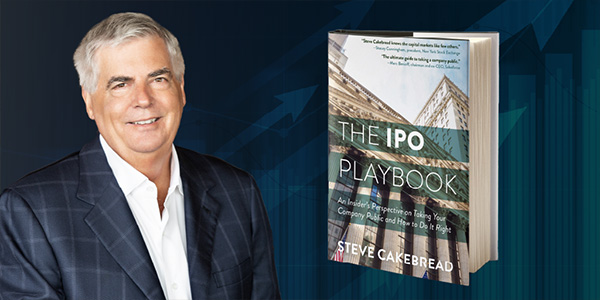
The IPO Playbook. I highly recommend it. Thank you again for being a guest.
Thank you, Robbie. It’s great to join you.
—
That was Steve Cakebread, author of The IPO Playbook: An Insider’s Perspective on Taking Your Company Public and How to Do It Right. Thank you for your support.
Important Links:
- Steve Cakebread – LinkedIn
- Salesforce
- Pandora
- Yext
- eHealth
- SolarWinds
- Bill.com
- The IPO Playbook
- Cakebread Winery

